Neuron secrete exosomes containing miR-9-5p to promote polarization of M1 microglia in depression
- PMID: 35264203
- PMCID: PMC8905830
- DOI: 10.1186/s12951-022-01332-w
Neuron secrete exosomes containing miR-9-5p to promote polarization of M1 microglia in depression
Abstract
Background: Neuroinflammation is an important component mechanism in the development of depression. Exosomal transfer of MDD-associated microRNAs (miRNAs) from neurons to microglia might exacerbate neuronal cell inflammatory injury.
Results: By sequence identification, we found significantly higher miR-9-5p expression levels in serum exosomes from MDD patients than healthy control (HC) subjects. Then, in cultured cell model, we observed that BV2 microglial cells internalized PC12 neuron cell-derived exosomes while successfully transferring miR-9-5p. MiR-9-5p promoted M1 polarization in microglia and led to over releasing of proinflammatory cytokines, such as interleukin-1β (IL-1β), interleukin-6 (IL-6) and tumor necrosis factor-alpha (TNF-α), which exacerbated neurological damage. Furthermore, we identified suppressor of cytokine signaling 2 (SOCS2) as a direct target of miR-9-5p. Overexpression of miR-9-5p suppressed SOCS2 expression and reactivated SOCS2-repressed Janus kinase (JAK)/signal transducer and activator of transcription 3 (STAT3) pathways. Consistently, we confirmed that adeno-associated virus (AAV)-mediated overexpression of miR-9-5p polarized microglia toward the M1 phenotype and exacerbated depressive symptoms in chronic unpredictable mild stress (CUMS) mouse mode.
Conclusion: MiR-9-5p was transferred from neurons to microglia in an exosomal way, leading to M1 polarization of microglia and further neuronal injury. The expression and secretion of miR-9-5p might be novel therapeutic targets for MDD.
Keywords: Depression; Exosomes; Microglial polarization; Neuroinflammation; miR-9-5p.
© 2022. The Author(s).
Conflict of interest statement
The authors declare that they have no competing interests.
Figures







References
-
- Daly EJ, Singh JB, Fedgchin M, Cooper K, Lim P, Shelton RC, Thase ME, Winokur A, Van Nueten L, Manji H, et al. Efficacy and safety of intranasal esketamine adjunctive to oral antidepressant therapy in treatment-resistant depression: a randomized clinical trial. JAMA Psychiatry. 2018;75(2):139–148. - PMC - PubMed
MeSH terms
Substances
Grants and funding
LinkOut - more resources
Full Text Sources
Miscellaneous

